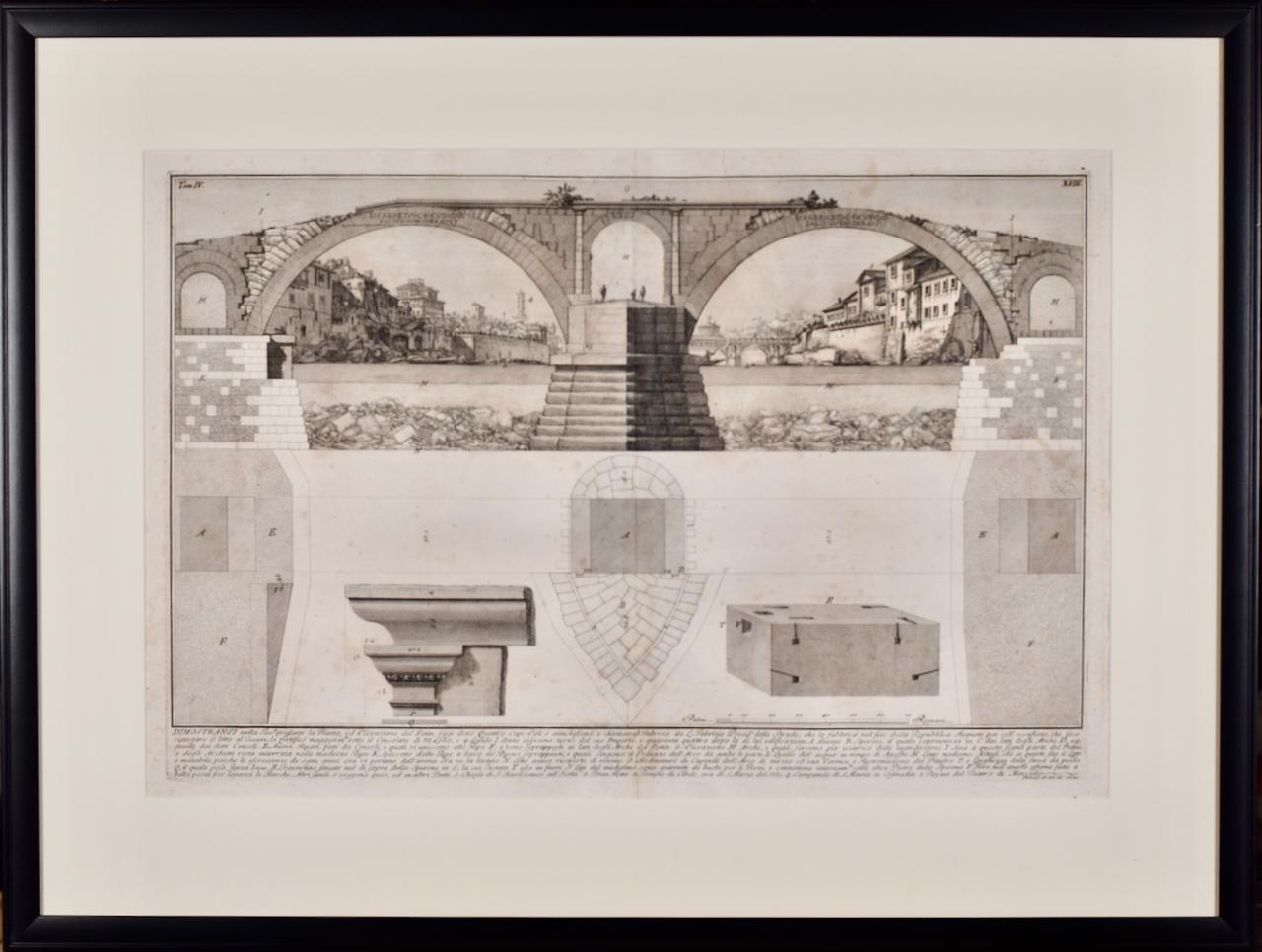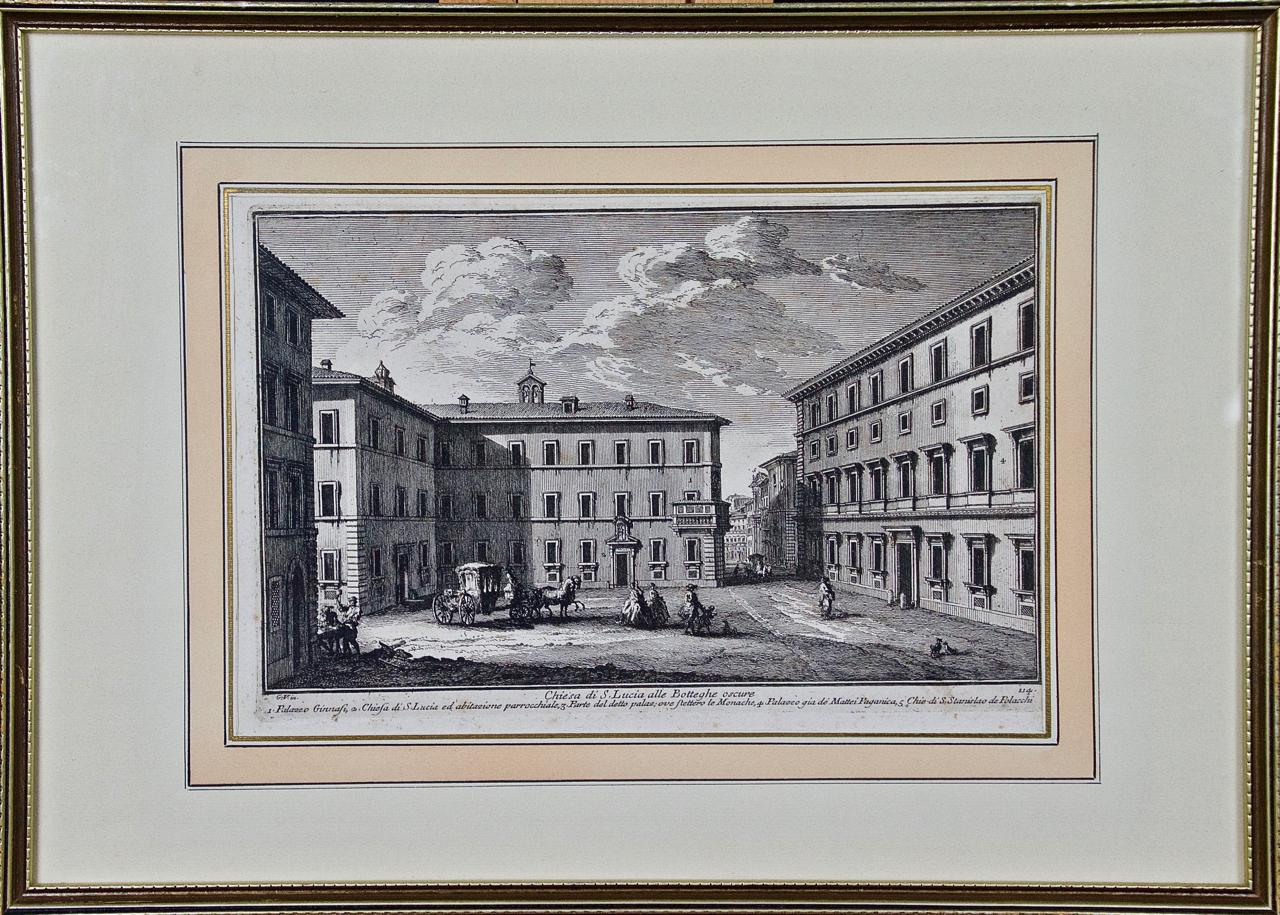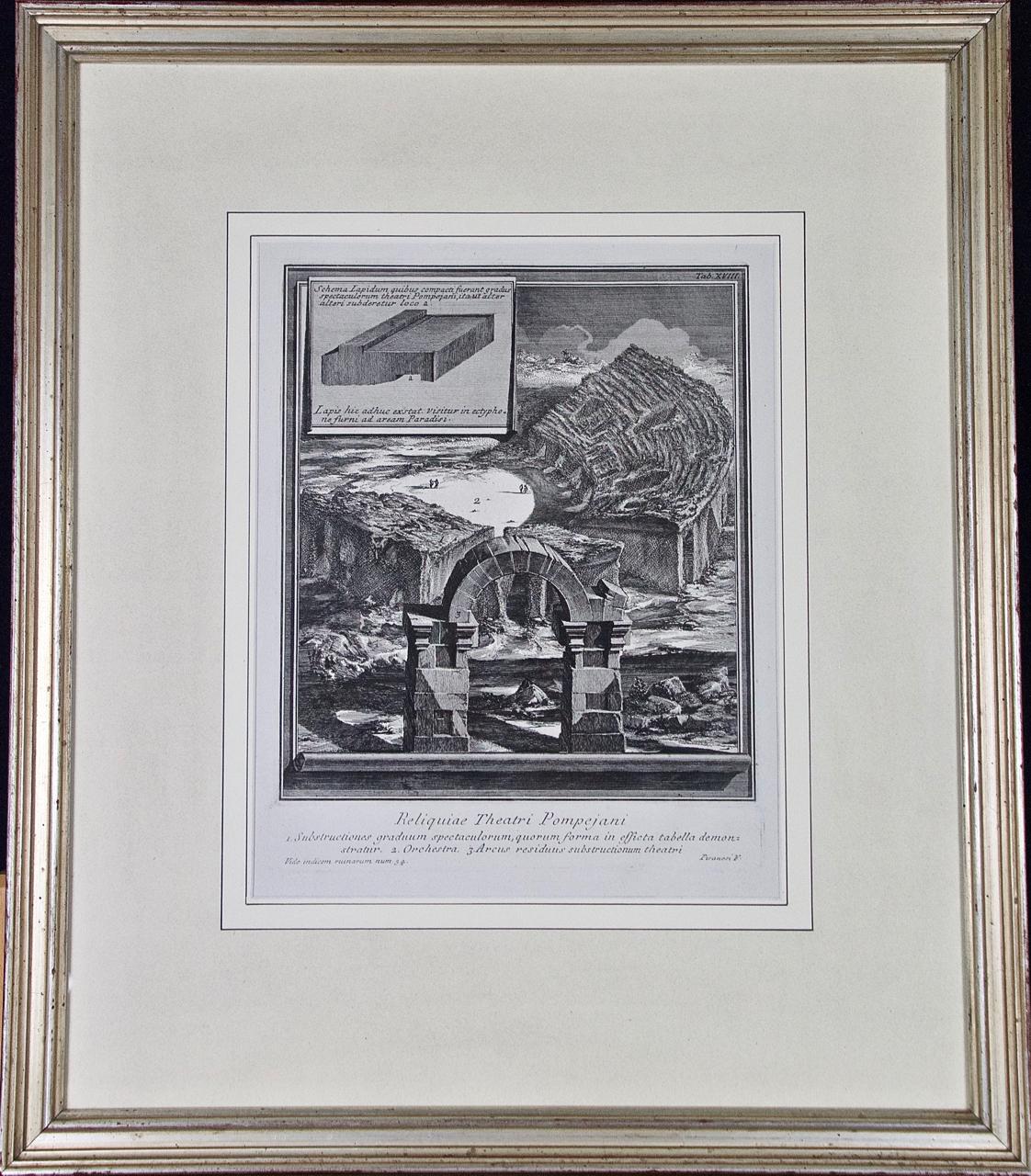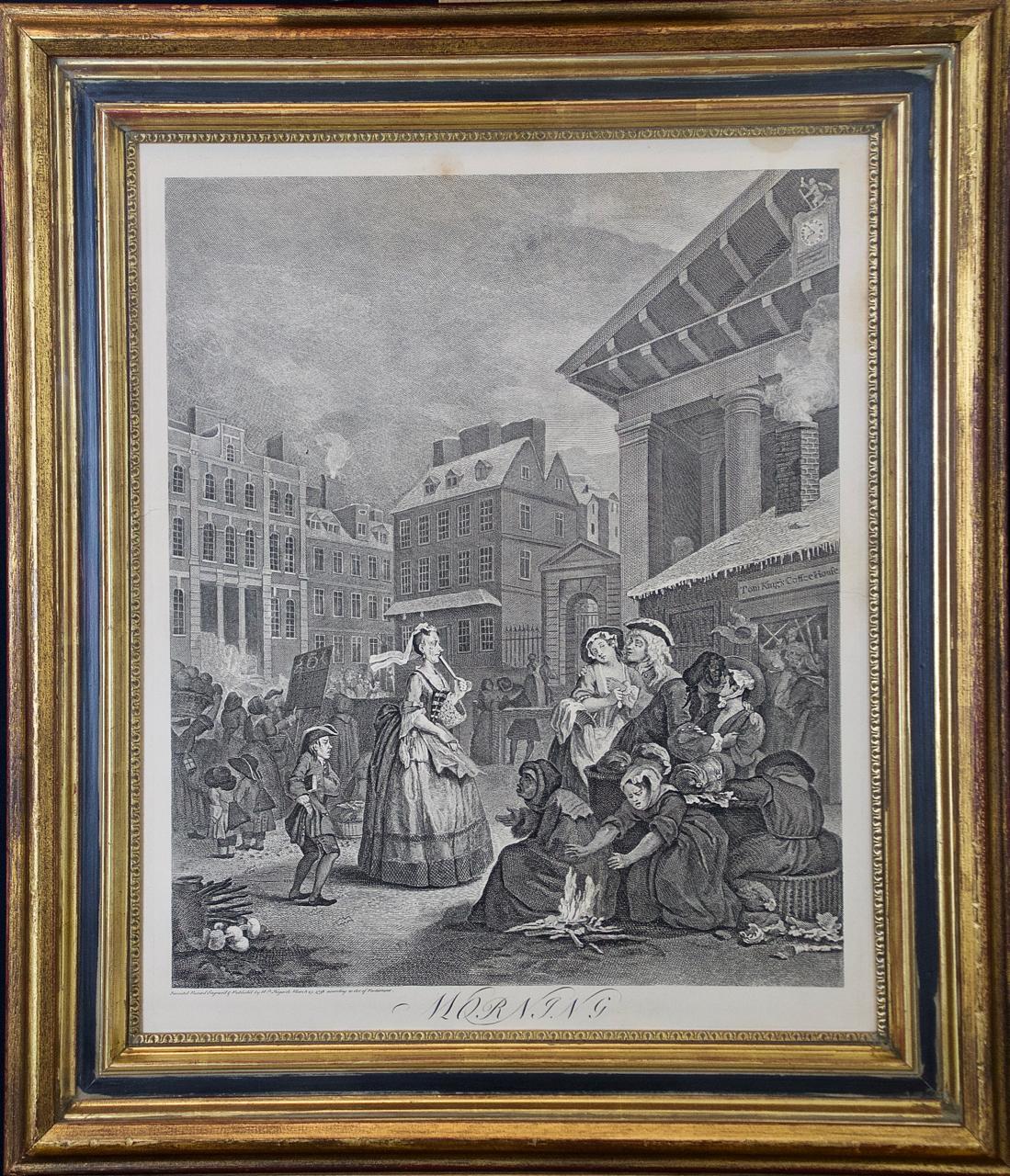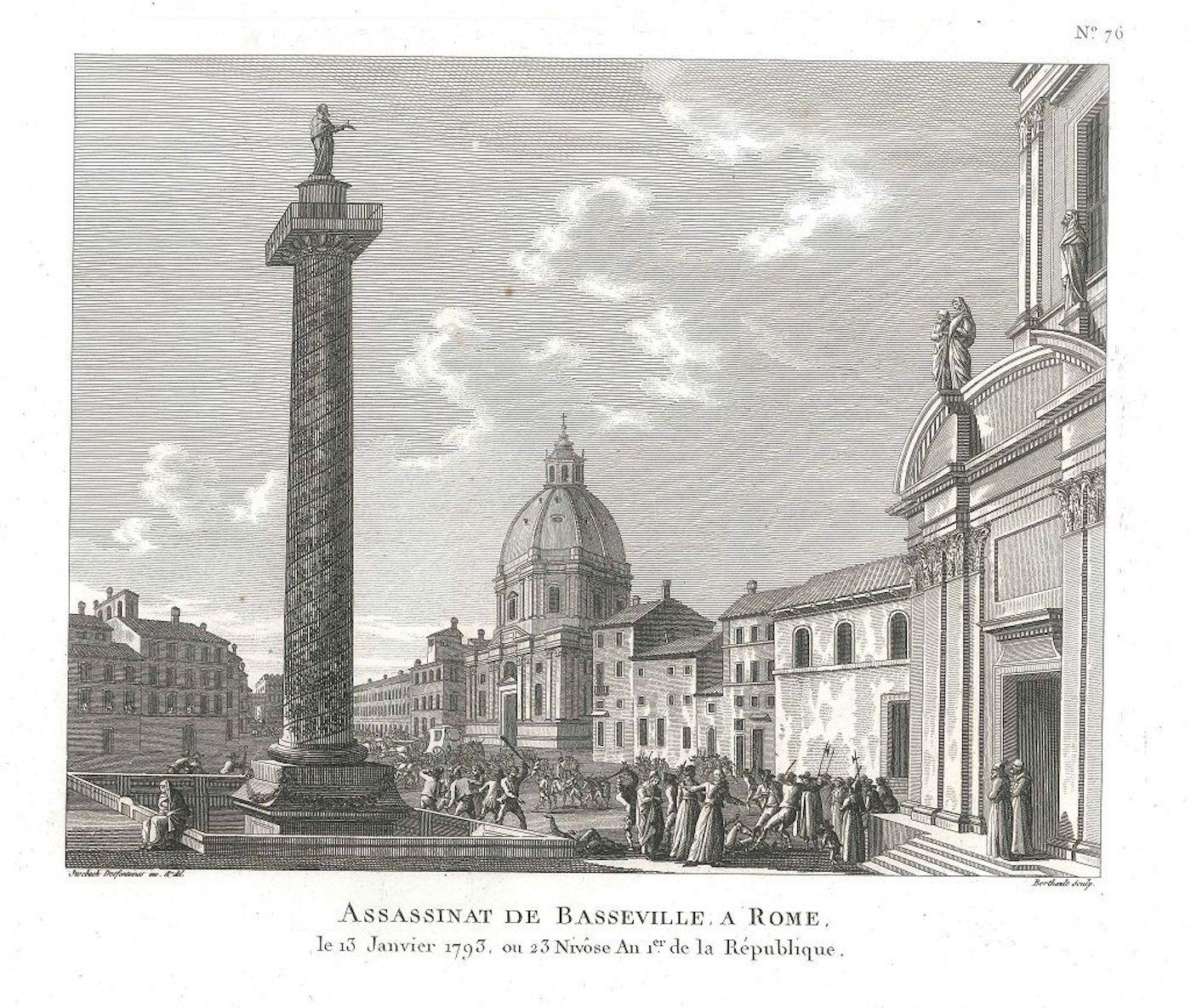Items Similar to The Arch of Constantine and the Colosseum
Want more images or videos?
Request additional images or videos from the seller
1 of 12
Giovanni Battista PiranesiThe Arch of Constantine and the Colosseum 1760
1760
About the Item
The Arch of Constantine and the Colosseum
Vedute dell' Arco di Costantino, e dell' Anfiteatro Flavio il Colosseo
From: "Vedute di Roma" (Roman Views), part II
An early Paris edition, on thin laid paper, no visible watermark
Inscription: At lower left: "1. Meta sudante / 2. Radice del Palatino / Presso l'Autore a Strada Felice vicnio alla Trinità de'Monti. A paoli due e mezzo."; bottom center: "Veduta dell'Arco di Costantino, e dell'Anfiteatro Flavio detto il Coloseo."; lower right: "3. Vestigie della Terme di Tito /4. Radice dell'Esquilino / Piranesi del. Scolp."
Signed in the plate lower right: Piranesi del. sculp.
Etching, 1760
Image/Plate size: 16 1/8 x 21 5/8 inches
Reference: Hind 56 iv/VI, the price eraced, but beofre the numbers in the plate
Wilton-Ely 1.195.152
Foclillon 805
Condition: Very good
Regarding Vedute di Roma
"By 1747, Piranesi had begun work on the Vedute di Roma, and he continued to create plates for this series until he died in 1778. Piranesi’s Vedute, which overshadowed competitor’s views of Roman landmarks through compelling compositions, strong lighting contrasts, and dramatic presentation, shaped European conceptions of present day Rome. This influenced European thought to such an extent that Grand Tourists, who had come to know Rome through Piranesi’s prints, were recorded as being disappointed on their first encounter with the real thing.39 The views were intended as tourist souvenirs and, from their instant popularity, Piranesi had obviously judged the market well. His early sites include obvious popular sights, such as Piazza della Rotonda and the Sepolcro di Cecilia Metella. The first thirty-four views were published in a single volume and entitled Le Magnificenze di Roma. In his first views, the monument or subject was drawn from a distance so that it was clearly set in its context. The little figures present at the ground level are the everyday people and visitors in contemporary Rome. As represented in the “Veduta della Piazza della Rotonda,” Piranesi, clearly contorting perspective, etched an exaggerated and extended view of the Rotonda, unfocused on a specific aspect of the scene. His later views featured heavier line, a sublime eye, and more dramatic perspectives. They also specifically concentrate on a monument, like the “Veduta del Ponte Salario,” or ruin instead of portraying a sweeping view of Roman landscape. These changes could possibly be a response to market demand and what Grand Tourists wanted to see in their vedute, or it could be a personal style change as Piranesi became intrigued by the idea of the sublime. Nevertheless, these views of Rome firmly established Piranesi’s reputation and gave him the initial financial stability that enabled him to tackle grander themes. Moreover, Piranesi’s interest in ruins was genuine antiquarian desire to preserve and record.40 Piranesi was able to focus in on his awareness of what was noble and magnificent and gain a sense for the sublime in the architectural tradition of Rome. Piranesi’s lifelong obsession with architecture, past and present, was fundamental to his genius. His etched plates contained remarkable imagination and a practical understanding of ancient technology. They created a perception of antiquity lasting to our own time."
Courtesy Wellesley University
- Creator:Giovanni Battista Piranesi (1720-1778, Italian)
- Creation Year:1760
- Dimensions:Height: 16.13 in (40.98 cm)Width: 21.63 in (54.95 cm)
- Medium:
- Movement & Style:
- Period:1760-1769
- Condition:
- Gallery Location:Fairlawn, OH
- Reference Number:
Giovanni Battista Piranesi
Piranesi was born in Venice in 1720 and died in Rome in 1778. He was the son of a stone mason and was trained as an architect. After a slow start he eventually achieved great success as an architect, archaeologist, artist, designer, collector, and antiquities dealer. His mission was to glorify the architecture of ancient Rome through his engravings and etchings. His highly dramatized prints often depict imaginary interiors and frequently include figures in mysterious activities, who are dwarfed by the magnitude of their monumental surroundings. Piranesi's style greatly influenced the neoclassical art movement of the late 18th century. His dramatic scenes inspired generations of set designers, as well as artists, architects and writers. His prints have continued to increase in value to institutions and collectors.
About the Seller
5.0
Recognized Seller
These prestigious sellers are industry leaders and represent the highest echelon for item quality and design.
Platinum Seller
These expertly vetted sellers are 1stDibs' most experienced sellers and are rated highest by our customers.
Established in 1978
1stDibs seller since 2013
712 sales on 1stDibs
Typical response time: 1 hour
Associations
International Fine Print Dealers Association
- ShippingRetrieving quote...Ships From: Akron, OH
- Return PolicyA return for this item may be initiated within 10 days of delivery.
More From This SellerView All
- View of the Ancient Structure built by Tarquinius Superbus called the Bel LidoBy Giovanni Battista PiranesiLocated in Fairlawn, OHView of the Ancient Structure built by Tarquinius Superbus called the Bel Lido, and like others built by Marcus Agrippa in the time of Augustus when he ...Category
1750s Old Masters Landscape Prints
MaterialsEtching
- XXXIII Fig. I Avanzo del Tempio di Castore e PolluceBy Giovanni Battista PiranesiLocated in Fairlawn, OHXXXIII Fig. I Avanzo del Tempio di Castore e Polluce .View of the Remains of the Peristyle of the House of Nero, Etching, 1756 Signed in the plate (see photo) From: Le Antichità Roma...Category
1750s Old Masters Landscape Prints
MaterialsEtching
- The Ponte and Castel S. Angelo (Veduta del Ponte e Castello Sant' Angelo)By Giovanni Battista PiranesiLocated in Fairlawn, OHThe Ponte and Castel S. Angelo Veduta del Ponte e Castello Sant' Angelo Etching, 1754 Signed in the plate lower right above the caption From: Vedute di Roma A proper Roman printing with the price in the lower right corner. Printed on a Double Circle Fleur de Lys watermark paper, c. 1760, with full margins. A brilliant impression . Note: A view of the Tiber River, Castello Sant' Angelo and St. Peter's Basilica in the distance. Watermark: Double Circle Fleur de Lys References: Robison c/g Hind 29 ii/VII Foclllon 793 Condition: A Roman printing before the numbers added in Paris. Printed on a Double Circle Fleur-de-Lys watermark paper. Right margin folded over 5/8 inches for framing. Usual centerfold as issued in the album. Slight aging to the sheet. Binding holes at the left margin edge Framed with plexi. Plate size: 14 7/8 x 22 7/8 inches Sheet size: 21 5/8 x 30 5/16 inches Frame size: 22 3/4 x 33 1/2 inches Sant’Angelo Bridge, Italian Ponte Sant’Angelo, ancient (Latin) Pons Aelius, ancient Roman bridge, probably the finest surviving in Rome itself, built over the Tiber by the emperor Hadrian (reigned 117–138 AD) to connect the Campus Martius with his mausoleum (later renamed Castel Sant’Angelo). The bridge was completed about AD 135. It consists of seven stone arches and five main spans of about 60 feet (18 m) each, supported on piers 24 feet (7 m) high. In the 13th century Pope Clement IV installed an iron balustrade and in the 16th century Pope Clement VII placed statues of Saints Peter and Paul...Category
1750s Old Masters Landscape Prints
MaterialsEtching
- Veduta dell'esterno della gran Basilica di S. Pietro in VaticanoBy Giovanni Battista PiranesiLocated in Fairlawn, OHVeduta dell'esterno della gran Basilica di S. Pietro in Vaticano (View of the Exterior of St. Peter's Basilica in the Vatican) Etching, 1748 From the first printing of the "Vedute di...Category
1740s Old Masters Landscape Prints
MaterialsEtching
- The Monumental TabletBy Giovanni Battista PiranesiLocated in Fairlawn, OHThe Monumental Tablet Etching, engraving, drypoint and burnishing, c. 1748 Series: Grotteschi (Grotesques, 4 plates) Original, unwashed condition. Excellent. Second edition first is...Category
1740s Old Masters Prints and Multiples
MaterialsEtching
- Scene II, Le Nozze Degli DeiBy Stefano Della BellaLocated in Fairlawn, OHScene II, Le Nozze Degli Dei Etching, 1637 Signed in the plate lower left The scene depicts the initial moment when Diana is revealed, surrounded by her nymphs, celebrating a success...Category
1630s Old Masters Landscape Prints
MaterialsEtching
You May Also Like
- Fabricius (Ponte Cestio) Bridge : Framed 18th C. Piranesi Architectural EtchingBy Giovanni Battista PiranesiLocated in Alamo, CAThis framed 18th century etching by Giovanni Battista Piranesi is entitled "Dimostransi nella Tav. presente la Pianta, ed Elevazione del Ponte, oggi detto Quattro Capi egli è antichissimo, e chiamavasi Fabrizio da L. Fabrizio Presid. delle Strade, che lo fabbrico' nel fine della Repubblica. "(The Plan and Elevation of the Bridge, today called Quattro Capi. The architect is very ancient, and was called Fabrizio da L. Fabrizio Presid. delle Strade, who built it at the end of the Republic). This is plate 18 in volume 4 of Piranesi's "Le antichita romane opera di Giambatista Piranesi architetto veneziano" (Roman antiquities by Giambatista Piranesi Venetian architect). It was published in Rome in 1756-1757. This etching depicts the plan and elevation of the bridge now called the Ponte dei Quattoro Capi or Ponte Cestio (Bridge of the Four Heads), which in antiquity was called the Bridge of Fabricius after L. Fabricius, the Superintendant of the Streets who built it at the end of the Republic, around 62 BC. It was also been known in the Middle Ages as ‘Ponte Giudeo’ (Bridge of the Jews). The bridge crossed from the left bank or northeast side of the Tiber River to Tiber Island...Category
1750s Old Masters Landscape Prints
MaterialsEtching
- 18th Century Etching of "Chiesa di S. Lucia" in Rome by Giuseppe VasiBy Giuseppe VasiLocated in Alamo, CAThis 18th century etching is entitled "Chiesa di S. Lucia alle Botteghe Oscure" by Giuseppe Vasi was published in Rome in 1747 in Vasi's 'Magnificenze di Roma Antica e Moderna', whic...Category
Mid-18th Century Old Masters Landscape Prints
MaterialsEtching
- Piranesi 18th C. Etching "Reliquiae Theartri Pompejani" an Ancient Roman TheaterBy Giovanni Battista PiranesiLocated in Alamo, CAThis a framed Giovanni Battista Piranesi (1720-1778) etching entitled "Reliquiae Theartri Pompejani" (Remains of the Theatre of Pompey) from "Il Campo Marzio dell'Antica Roma" (The C...Category
Mid-18th Century Old Masters Landscape Prints
MaterialsEtching
- Four Framed Hogarth Engravings "Four Times of the Day"By William HogarthLocated in Alamo, CAThe four plates in this "Four Times of the Day" set were created utilizing both engraving and etching techniques by William Hogarth in 1738. Hogarth's original copper plates were refurbished where needed by James Heath and these engravings were republished in London in 1822 by Braddock, Cradock & Joy. This was the last time Hogarth's original copper plates were used for printing. Most were melted down during World War I for the construction of bombs. Printed upon early nineteenth century wove paper and with large, full margins as published by William Heath in 1822. The inscription below each print reads "Invented Painted & Engraved by Wm. Hogarth & Publish'd March 25. 1738 according to Act of Parliament". These large folio sized "Four Times of the Day" engravings/etchings are presented in complex gold-colored wood frames with black bands and scalloped gold inner trim. A majority of each thick impressive frame is covered with glass applied near the outer edge. Each frame measures 25.75" high, 22.25" wide and 1.88" deep. There are a few small dents in the edge of these frames, which are otherwise in very good condition. "Morning" has two focal areas of discoloration in the upper margin and some discoloration in the right margin, a short tear in the left margin and a short tear or crease in the right margin. "Noon" has a spot in the upper margin that extends into the upper image, but it is otherwise in very good condition. "Evening" has a faint spot in the upper margin, but it is otherwise in very good condition. "Night" is in excellent condition. The "Four Times of the Day" series is in the collection of many major museums, including: The British Museum, The Metropolitan Museum of Art, The Tate Museum, The Chicago Art Institute and The Victoria and Albert Museum. Through this series Hogarth is portraying early 18th century London street life at "Four Times of the Day". His characters are exhibiting their personalities, quircks, strange activities, but he also wants to draw attention the disparities between the wealthy aristocracy and the common working class. Plate 1, "Morning" depicts morning in Covent Garden in the winter in front of Tom King...Category
Mid-18th Century Old Masters Landscape Prints
MaterialsEngraving, Etching
- Assassinat de Basseville à Rome - Original Etching by P.G. Berthault - 1793By Pierre Gabriel BerthaultLocated in Roma, ITAssassinat De Basseville à Rome is an original black and white etching realized by Pierre Gabriel Berthault, after Jacques François Joseph Swebach-Desfontaines in 1793. Title with caption on plate on the lower center: "Assassinat de Basseville, à Rome/ le 13 Janvier 1793, ou 23 Nivose An Ier de la République". Below the image on the lower margin, "Swebach Desfontaines onv. et del. / Berthault sculp." is etched on plate. This modern artwork is numbered "N. 76", because it is from the series Les Tableaux historiques de la Révolution française. As a matter of fact, Pierre-Gabriel Berthault is well-known for having engraved plates from this collection with the collaboration of the engraver Jean Duplessis-Bertaux. A work - hanging in the balance between news and history - with illustrations of salient or minimal events occurred during the French Revolution. As a celebration of the new ideals of brotherhood, justice, and equality, Les Tableaux immediately became a point of reference for journalism at the time. Of traditional cut, namely showing a view with many human figures, the engraving simplified the lines to be immediately readable for the general public. In our specific case, this original print represents the murder of Hugou de Bassville or Basseville (7 February, 1743 – 13 January, 1793), a French journalist and diplomatist, and protector of the radical Jacobins in Rome. In excellent conditions, except for a usual yellowing of the paper on the edges and a light trace of oxidations on the lower and right margins, beyond the marginal line of the matrix. Pierre-Gabriel Berthault (Saint-Maur-des-Fossés, 1737 - Paris, 1831) was a French master who made engravings from drawings by Jean-Claude Richard de Saint-Non (known as the Abbot of Saint-Non) and from paintings by Louis François Cassas. He depicted many views of Italy and created the collections Voyage à Naples and Voyage pittoresque de la Syrie, de la Palestine et de la basse-Egypte. Before the French Revolution, he was famous for being the author of the Vues intérieures de Paris and for tables with architectural elevations.Category
1790s Old Masters Landscape Prints
MaterialsEtching
- The Passengers - Original Etching by A. M. de Ghuy - 1775Located in Roma, ITThe Passenger is an original artwork realized by Antoine de Marcenay de Ghuy in 1775. Original etching on paper. Titled on the lower margin at the center. The artwork is glued on ca...Category
1770s Old Masters Landscape Prints
MaterialsEtching
